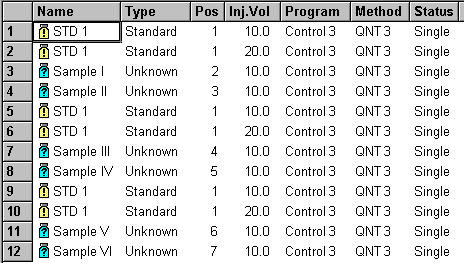Calibration Examples
![]() Calibration Mode: Group
Calibration Mode: Group
The Group Calibration Mode completes the Total and Additional modes. The Group mode is used when there are time-dependent modifications during the analysis, for example, decomposition of the analyzed substance.
The mode is described using the example of the Additional mode (sample list of alternating sample pairs (2 standards, 2 samples, 2 standards, etc.).
a) User Input:
Sample List

QNT Method/Peak Table Tab

QNT Method/General Tab
If the user selects the Group mode, each sample is evaluated based on the standard sample in the sample list that has been analyzed immediately before.
QNT Method/Calibration Tab
This page indicates all standard samples (of a sequence) that are used for calibrating the current sample.
Press the F4 key or the SHIFT+F4 key combination to open the samples of a sequence one after the other. The standard samples forming the basis for calibration are shown for each sample.
This means in the example that in the Group mode the standard samples from the lines 1 and 2 are displayed for the samples I and II. The standard samples from lines 5 and 6 are displayed for the samples III and IV, and the standard samples from lines 9 and 10 for the samples V and VI.
b) Evaluation:
Evaluation is similar to the examples with the external calibration (modes: Total and Additional). The only difference is that the calibration curve is constantly updated without considering the previously analyzed standard samples.
For the example, this means:
Samples I and II are evaluated by means of a two-point calibration of the standard samples in the lines no. 1 and 2.
In contrast to the Additional mode, samples III and IV are also evaluated by means of a two-point calibration. However, only the standard samples STD 1 from lines no. 5 and 6 are used.
Correspondingly, the samples V and VI are evaluated by means of the standard samples STD 1 in the lines no. 9 and no. 10.
For an overview of the different calibration possibilities provided by Chromeleon, refer to How to …: ![]() Calibrating.
Calibrating.